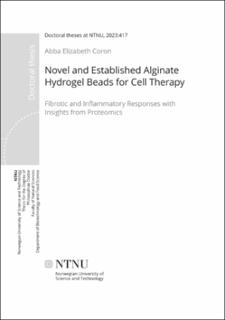| dc.contributor.advisor | Strand, Berit L. | |
| dc.contributor.advisor | Rokstad, Anne Mari Aukan | |
| dc.contributor.author | Coron, Abba Elizabeth | |
| dc.date.accessioned | 2024-01-19T12:45:32Z | |
| dc.date.available | 2024-01-19T12:45:32Z | |
| dc.date.issued | 2023 | |
| dc.identifier.isbn | 978-82-326-7533-3 | |
| dc.identifier.issn | 2703-8084 | |
| dc.identifier.uri | https://hdl.handle.net/11250/3112831 | |
| dc.description.abstract | Encapsulation of pancreatic islets in immunoprotective alginate hydrogel microspheres represents a promising alternative to current therapies for type 1 diabetes. By providing a semipermeable barrier, this strategy protects the graft from immediate immune attack and eliminates the need for immunosuppression with its inherent health risks. However, no clinical trial has yet succeeded in maintaining the long-term function of grafted islets. Several challenges associated with alginate microsphere encapsulation have been identified, including hydrogel instability and pericapsular fibrotic overgrowth (PFO), which may lead to graft failure. While foreign body reactions to biomaterials are well-documented and begin with protein adsorption, the specific proteins that adsorb to alginate microspheres and their role in PFO development remain to be elucidated.
One primary objective of this thesis was to develop alginate microbeads with sustained efficacy for cell encapsulation therapy in the treatment of type 1 diabetes. This involved formulating and characterising alginate microbeads with high stability and minimal PFO. Stable microbeads were achieved using intermediate guluronate (G) alginate and chemically modified alginate with sulfate groups. These microbeads demonstrated minimal PFO in immunocompetent mice compared to high G microbeads used in previous clinical trials, and low inflammatory responses was observed in human whole blood. The immunoprotective capabilities of both high G and sulfated alginate beads were demonstrated through encapsulated rat islets transplanted into diabetic mice, which exhibited glucose-responsive islets for the study duration of 120 days. Intermediate G alginate beads maintained normoglycemia for 50 days in the same mouse model, where the results were likely obstructed by precipitate formation inside the beads.
We also hypothesised that investigating the adsorbed proteins on alginate microspheres could provide valuable insights into the different host responses observed for these microspheres. Thus, we developed a novel mass spectrometry (MS)-based proteomics approach for in-depth protein profiling of the materials, which included high G alginate and sulfated alginate microbeads, along with poly-L-lysine-coated microbeads. The use of lepirudin-anticoagulated human plasma enabled the investigation of acute-phase proteins within the complement and coagulation systems, which are critical in biomaterial-mediated host responses. Sulfated alginate microbeads were highly enriched with complement inhibitors, coagulation factors, and numerous proteins with potential anti-fibrotic effects, conforming to a low-inflammatory and anti-fibrotic profile. High G alginate microbeads were enriched with moderate levels of complement inhibitors, conforming to a low-inflammatory but fibrotic profile. The pro-inflammatory poly-L-lysine-coated microbeads, known to be prone to PFO, displayed the highest enrichment of complement activating factors. In summary, this research has demonstrated alginate microbeads that hold promise for the future treatment of type 1 diabetes. It has provided new tools and knowledge to further our understanding of initial protein adsorption and its role in the development of PFO on alginate microspheres. | en_US |
| dc.language.iso | eng | en_US |
| dc.publisher | NTNU | en_US |
| dc.relation.ispartofseries | Doctoral theses at NTNU;2023:417 | |
| dc.relation.haspart | Paper 1: Strand, Berit Løkensgard; Coron, Abba Elizabeth; Skjåk-Bræk, Gudmund. Current and Future Perspectives on Alginate Encapsulated Pancreatic Islet. Stem Cells Translational Medicine 2017 ;Volum 6.(4) s. 1053-1058. Published by Oxford University Press. This is an open access article under the terms of the Creative Commons Attribution License CC BY. | en_US |
| dc.relation.haspart | Paper 2: Coron, Abba E.; Kjesbu, Joachim Sebastian; Kjærnsmo, Fredrikke; Oberholzer, José; Rokstad, Anne Mari A.; Strand, Berit Løkensgard. Pericapsular fibrotic overgrowth mitigated in immunocompetent mice through microbead formulations based on sulfated or intermediate G alginates. Acta Biomaterialia 2021 ;Volum 137. s. 172-185. © 2021 Acta Materialia Inc. Published by Elsevier Ltd. All rights reserved. | en_US |
| dc.relation.haspart | Paper 3: Coron, Abba Elizabeth; Fonseca, Davi de Miranda; Sharma, Animesh; Slupphaug, Geir; Strand, Berit Løkensgard; Rokstad, Anne Mari A.. MS-proteomics provides insight into the host responses towards alginate microspheres. Materials Today Bio 2022 ;Volum 17. s. 1-20. Published by Elsevier Ltd. This is an open access article under the CC BY license. | en_US |
| dc.relation.haspart | Paper 4: Kjesbu, Joachim a.; Coron, Abba E.; Bochenek, Matthew; Rios, Peter; Isa, Douglas; Joshi, Ira; Ghani, Sofia; Oberholzer; José; Rokstad, Anne M. A.; Strand, Berit Løkensgard. Function of encapsulated rat islets in sulfated and intermediate G alginate in diabetic immunocompetent and immunodeficient mice. This paper is not yet published and is therefore not included. | en_US |
| dc.title | Novel and Established Alginate Hydrogel Beads for Cell Therapy - Fibrotic and Inflammatory Responses with Insights from Proteomics | en_US |
| dc.type | Doctoral thesis | en_US |
| dc.subject.nsi | VDP::Teknologi: 500::Næringsmiddelteknologi: 600 | en_US |

